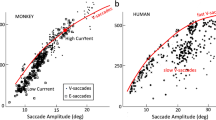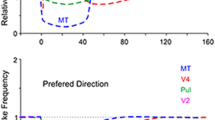Abstract
The main input of the lateral part of the cat's lateralis posterior-pulvinar complex (LP-P) comes from the primary visual cortex. We investigated the response properties of cells in area 17 projecting to the striate-recipient zone (LPl) of the cat's LP-P complex. The cells' receptive fields were stimulated with drifting sine-wave gratings. Cells whose fibres terminate in the superior colliculus were also recorded, to determine how their properties compare with those of cortico-LPl cells and to investigate the possibility that LPl is innervated by collaterals of cortico-tectal units. A total of 26 cells in the striate cortex were identified by antidromic activation from the LPl (mean latency 2.2 ms) and 22 from the colliculus (mean latency 2.5 ms). Only six cortical cells could be activated from the LPl and the colliculus. All cortico-LPl cells except for two responded to drifting sinusoidal gratings with unmodulated discharges (AC/DC ratios <1). On the basis of their modulation index, these units were classified as complex cells. All cortico-LPl cells were selective for the orientation of gratings (mean bandwidth of 28°). There was a tendency for cortico-LPl cells to prefer vertical and horizontal orientations. More than half of these cells (57%) were direction selective. Strong orientation anisotropies were also found in the receptive fields of cortico-tectal cells, since almost all units responded preferentially to horizontally oriented gratings. The mean preferred spatial and temporal frequencies of cortico-LPl cells were 0.74 c/deg (bandwidth 2.03 octaves) and 2.7 Hz (bandwidth 2.5 octaves), respectively. These properties did not differ significantly from those of cortico-tectal cells. Most cortico-LPl cells (72%) exhibited contrast-response curves with saturation at low contrast (mean half-saturation 0.2). For the remaining units, the responses increased linearly with contrast without clear saturation. For more than half of cortico-tectal cells (60%), the contrast function was also characterised by a response saturation. Almost all cortico-LPl cells responded to moving random dot patterns with mean tuning functions of 43.6°. “Standard” as well as “special” complex cells were found to be equally responsive to the motion of visual noise. Similar properties were recorded for cortico-tectal cells (mean bandwidth of 44.2°). Cortico-LPl and cortico-tectal cells were either binocularly or monocularly driven by the contralateral eye and their mean spontaneous firing rates were 11.7 and 10.9 spikes/s, respectively. These cells were presumably located in layer V. Stimulation of LPl and colliculus also evoked trans-synaptic responses in area 17. The average latency of the orthodromic responses from LPl was much shorter than that from the colliculus (medians 3.5 and 50 ms, respectively). The findings indicate that almost all cortico-LPl units have complex receptive fields and that their overall properties differ from those of recipient cells in LPl. These results also indicate that LPl is not likely to be innervated by collaterals of fibres of cortico-tectal cells. While cortico-LPl and cortico-tectal cells appear to form two distinct populations, there is no significant difference between the overall properties of these two cell groups.
Similar content being viewed by others
References
Abramson BP, Chalupa LM (1985) The laminar distribution of cortical connections with the tecto-and cortico-recipient zones in the cat's lateral posterior nucleus. Neuroscience 15:81–95
Abramson BP, Chalupa LM (1988) Multiple pathways from the superior colliculus to the extrageniculate visual thalamus of the cat. J Comp Neurol 271:397–418
Albrecht DG, Hamilton DB (1982) Striate cortex of monkey and cat: contrast response function. J Neurophysiol 48:217–237
Benedek G, Norita M, Creutzfeld OD (1983) Electrophysiological and anatomical demonstration of an overlapping striate and tectal projection to the lateral posterior-pulvinar complex of the cat. Exp Brain Res 52:157–169
Berman N, Cynader M (1975) Receptive fields in cat superior colliculus after visual cortex lesions. J Physiol (Lond) 245:261–270
Berson DM, Graybiel AM (1978) Parallel thalamic zones in the LP-pulvinar complex of the cat identified by their afferent and efferent connections. Brain Res 147:139–148
Berson DM, Graybiel AM (1983) Organization of the striate-recipient zone of the lateralis posterior-pulvinar complex and its relation with the geniculostriate system. Neuroscience 9:337–372
Bishop PO, Kozak W, Vakkur GJ (1962) Some quantitative aspects of the cat's eye: axis and plane of reference, visual field co-ordinates and optics. J Physiol (Lond) 163:466–502
Bisti S, Sireteanu RC (1976) Sensitivity to spatial frequency and contrast of visual cells in the cat superior colliculus. Vision Res 16:247–251
Casanova C (1991) Properties of cells in area 17 projecting to the cat's lateral posterior-pulvinar complex. Soc Neurosci Abstr 17:1377
Casanova C (1992) Response properties of complex cells in area 17 projecting to the lateralis posterior nucleus and to the superior colliculus in cats. Invest Ophthalmol Vis Sci (Suppl) 33:1214
Casanova C, Freeman RD, Nordmann JP (1989) Monocular and binocular response properties of cells in the striate-recipient zone of the cat's lateral posterior-pulvinar complex. J Neurophysiol 62:544–557
Casanova C, Nordmann JP, Molotchnikoff S (1991) Le complexe noyau latéral postérieur-pulvinar des mammifères et la fonction visuelle. J Physiol (Paris) 85:44–57
Casanova C, Nordmann JP, Ohzawa I, Freeman RD (1992) Direction selectivity of cells in the cat's striate cortex: differences between bar and grating stimuli. Visual Neurosci 9:505–513
Chalupa LM (1991) Visual function of the pulvinar. In: Leventhal AG (eds) The neural basis of visual function, Vol 4. CRC Press, Boca Raton, pp 141–159
Chalupa LM, Abramson BP (1988) Receptive-field properties in the tecto- and striate-recipient zones of the cat's lareral posterior nucleus. Prog Brain Res 75:85–94
Chalupa LM, Abramson BP (1989) Visual receptive fields in the striate recipient zone of the posterior-pulvinar complex. J Neurosci 9:347–357
Edelstyn NMJ, Hammond P (1988) Correlation of texture-sensitive complex cells with cortical layering of feline striate cortex. J Physiol (Lond) 396:145P
Fernald R, Chase R (1971) An improved method for plotting retinal landmarks and focusing the eyes. Vision Res 11:95–96
Fuller JH, Schlag JD (1976) Determination of antidromic excitation by the collision test: problems of interpretation. Brain Res 112:283–298
Gilbert CD (1977) Laminar differences in receptive field properties of cells in cat primary visual cortex. J Physiol (Lond) 268:391–421
Gilbert CD, Kelly JP (1975) The projections of cells in different layers of the cat's visual cortex. J Comp Neurol 163:81–106
Graybiel AM, Berson DM (1980) Histochemical identification and afferent connections of subdivisions in the lateralis-pulvinar complex and related thalamic nuclei in the cat. Neurosci 5:1175–1238
Harvey AR (1980) A physiological analysis of subcortical and commisural projections of area 17 and 18 of the cat. J Physiol (Lond) 302:507–534
Holländer H (1974) On the origin of the corticotectal projections in the cat. Exp Brain Res 21:433–439
Hubel DH, Wiesel TN (1962) Receptive fields, binocular interaction and functional architecture in the cat's visual cortex. J Physiol (Lond) 160:106–154
Hughes MJ, Chalupa LM (1982) Cortical cooling depresses visual neuronal responses in the tecto-recipient zone of the cat's lateral posterior-pulvinar nucleus. Soc Neurosci Abstr 8:673
Humphrey DR, Schmidt EM (1990) Extracellular single unit recording methods. In: Baker GB, Vanderwolf CH (eds) Neuromethods. Humana Press, Clifton, N. J.
Hutchins B, Updyke BV (1989) Retinotopic organization within the lateral posterior complex of the cat. J Comp Neurol 285:350–398
Kaas JH, Harting JK, Guillery RW (1974) Representation of the complete retina in the contralateral superior colliculus of some mammals. Brain Res 65:343–346
Kawamura S, Sprague JM, Niimi K (1974) Corticofugal projections from the visual cortices to the thalamus, pretectum and superior colliculus in the cat. J Comp Neurol 158:339–362
Levick WR (1972) Another tungsten microelectrode. Med Biol Eng 10:510–515
Lund JS, Henry GH, MacQueen CL, Harvey AR (1979) Anatomical organization of the primary visual cortex (area 17) of the cat. A comparison with area 17 of the macaque monkey. J Comp Neurol 184:599–618
Magalhães-Castro HH, Saraiva PES, Magalhães-Castro B (1975) Identification of corticotectal cells of the visual cortex of cats by means of horseradish peroxidase. Brain Res 83:474–479
Mason R (1978) Functional organization in the cat's pulvinar complex. Exp Brain Res 31:51–66
Mason R (1981) Differential responsiveness of cells in the visual zones of the cat's LP-pulvinar complex to visual stimuli. Exp Brain Res 43:25–33
Movshon JH, Thompson ID, Tolhurst DJ (1978) Receptive field organization of complex cells in the cat's striate cortex. J Physiol (Lond) 283:79–99
Ogasawara K, McHaffie JG, Stein BE (1984) Two visual corticotectal systems in cat. J Neurophysiol 52:1226–1245
Palmer LA, Rosenquist AC (1974) Visual receptive fields of single striate cortical units projecting to the superior colliculus in the cat. Brain Res 67:27–42
Raczkowski D, Rosenquist AC (1983) Connections of the multiple visual cortex areas with the lateral posterior-pulvinar complex and adjacent thalamic nuclei in the cat. J Neurosci 3:1912–1942
Rosenquist AC, Palmer LA (1971) Visual receptive field properties of cells of the superior colliculus after cortical lesions in the cat. Exp Neurol 33:629–652
Rosenquist AC, Raczkowski D, Symonds L (1982) The functional organization of the lateral posterior-pulvinar complex in the cat. In: Morrison AR, Strick PL (eds) Changing concepts of the nervous system. Academic Press, New York, pp 261–279
Saul AB, Humphrey AL (1992) Temporal-frequency tuning of direction selectivity in cat visual cortex. Visual Neurosci 8:365–372
Singer W, Tretter F, Cynader M (1975) Organization of cat striate cortex: a correlation of the receptive field properties with afferent and efferent connections. J Neurophysiol 38:1080–1098
Skottun BC, Freeman RD (1984) Stimulus specificity of binocular cells in the cat's visual cortex: ocular dominance and the matching of left and right eyes. Exp Brain Res 56:206–216
Skottun BC, De Valois RL, Grosof DH, Movshon JA, Albrecht DG, Bonds AB (1991) Classifying simple and complex cells of the basis of response modulation. Vision Res 31:1079–1086
Swadlow HA, Weyand TG (1981) Efferent systems of the rabbit visual cortex: laminar distribution of the cells of origin, axonal conduction velocities, and identification of axonal branches. J Comp Neurol 203:799–822
Tusa RJ, Palmer LA, Rosenquist AC (1978) The retinotopic organization of area 17 (striate cortex) of the cat. J Comp Neurol 177:213–236
Updyke BV (1977) Topographic organization of the projections from cortical area 17, 18 and 19 onto the thalamus, pretectum and superior colliculus in the cat. J Comp Neurol 173:81–122
Updyke BV (1981) Projection from visual areas of the middle suprasylvian sulcus onto the lateral posterior complex and adjacent thalamic nuclei in cat. J Comp Neurol 201:477–506
Weyand TG, Malpeli JG, Lee C, Schwark HD (1986a) Cat area 17. III. Response properties and orientation anisotropies of corticotectal cells. J Neurophysiol 56:1088–1101
Weyand TG, Malpeli JG, Lee C, Schwark HD (1986b) Cat area 17. IV. Two types of corticotectal cells defined by controlling geniculate inputs. J Neurophysiol 56:1102–1108
Weyand TG, Malpeli JG, Lee C (1991) Area 18 corticotectal cells: response properties and identification of sustaining geniculate inputs. J Neurophysiol 65:1078–1088
Author information
Authors and Affiliations
Rights and permissions
About this article
Cite this article
Casanova, C. Response properties of neurons in area 17 projecting to the striate-recipient zone of the cat's lateralis posterior-pulvinar complex: comparison with cortico-tectal cells. Exp Brain Res 96, 247–259 (1993). https://doi.org/10.1007/BF00227105
Received:
Accepted:
Issue Date:
DOI: https://doi.org/10.1007/BF00227105




